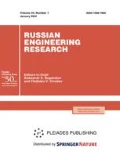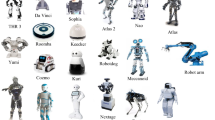Abstract
Construction of a speech module for a social autonomous robot permitting communication with humans is considered. The goal of the dialog is to assess the human’s state of health, characterized by a set of specified health parameters (a health profile). The structure of the speech module for robot–human dialog permitting health assessment is determined. Tests of a speech-module mockup demonstrate its effectiveness.

Similar content being viewed by others
REFERENCES
Dautenhahn, K., Socially intelligent robots: dimensions of human-robot interaction, Philos. Trans. R. Soc., B, 2007, vol. 362, no. 1480, pp. 679–704. https://doi.org/10.1098/rstb.2006.2004
Iengo, S., Human gesture recognition and robot attentional regulation for human-robot interaction, PhD Thesis, Napoli, 2014.
Kronander, K. and Billard, A., Learning compliant manipulation through kinesthetic and tactile human-robot interaction, IEEE Trans. Haptics, 2014, vol. 7, no. 3, pp. 367–380.
Shridhar, M. and Hsu, D., Interactive, visual grounding of referring expressions for human-robot interaction, Proc. XIV Conf. “Robotics: Science and Systems,” Pittsburgh, PA, 2018. http://www.roboticsproceedings.org/rss14/p28.pdf.
Thomason, J., Zhang, S., and Stone, P., Learning to interpret natural language commands through human-robot dialog, Proc. Twenty-Fourth Int. Joint Conf. on Artificial Intelligence, Buenos Aires, Argentina, Palo Alto, CA: AAAI Press, 2015, pp. 1923–1929.
Bordes, A. and Weston, J., Learning end-to-end goal-oriented dialog, Proc. 5th Int. Conf. on Learning Representations, ICLR 2017, Toulon, 2017.
Zhao, T. and Eskénazi, M., Zero-shot dialog generation with cross-domain latent actions, Proc. 19th Annual SIGdial Meeting on Discourse and Dialogue, Stroudsburg, PA: Assoc. Comput. Ling., 2018, pp. 1–10.
Das, A., Kottur, S., et al., Visual dialog, IEEE Trans. Pattern Anal. Mach. Intell., 2019, vol. 41, no. 5, pp. 1242–1256.
Shklyar, V.N., Nadezhnost’ sistem upravleniya (Reliability of Control Systems), Tomsk: Tomsk. Politekh. Univ., 2009.
Date, C.J., An Introduction to Database Systems, Boston: Pearson, 2003, 8th ed.
Kuznetsov, S.D., Osnovy baz dannykh (Principles of Database), Moscow: BINOM, Laboratoriya Znanii, 2007.
Zhidkov, V.N., Myagkie vychisleniya v integrirovannykh sistemakh letatel’nykh apparatov: uchebnoe posobie (Soft Calculations in Integrated Systems of Aircrafts: Manual), Moscow: Mosk. Aviats. Inst., 2013.
Giarratano, J.C. and Riley, G.D., Expert Systems: Principles and Programming, Boston, MA: Course Technology, 2004, 4th ed.
Mikhailov, A.A. and Dvoretskii, L.I., Spravochnik prakticheskogo vracha (Handbook of Practicing Physician), Moscow: Eksmo, 2007.
Këpuska, V. and Bohouta, G., Comparing speech recognition systems (Microsoft API, Google API and CMU Sphinx), Int. J. Eng. Res. Appl., 2017, vol. 7, no. 3 (2), pp. 20–24.
Lamere, P., Kwok, P., Walker, W., et al., Design of the CMU Sphinx-4 decoder, Proc. 8th European Conf. on Speech Communication and Technology, Geneva, 2003, pp. 1181–1184. https://www.isca-speech.org/archive/ archive_papers/eurospeech_2003/e03_1181.pdf.
Mamatov, N., Samijonov, A., Nurimov, P., and Niyozmatova, N., Karakalpak speech recognition with CMU Sphinx, Int. J. Innovative Technol. Explor. Eng, 2019, vol. 8, no. 10, pp. 2446–2448.
Dhankar, A., Study of deep learning and CMU sphinx in automatic speech recognition, Proc. Int. Conf. on Advances in Computing, Communications and Informatics (ICACCI), Piscataway, NJ: Inst. Electr. Electron. Eng., 2017, pp. 2296–2301.
Kayte, S. and Gawali, B., A text-to-speech synthesis for Marathi language using festival and Festvox, Int. J. Comput. Appl., 2015, vol. 3, no. 5, pp. 30–41.
De Silva, P., Wattanavekin, T., Hao, T., and Pipatsrisawa, K., Voice builder: a tool for building text-to-speech voices, Proc. Eleventh Int. Conf. on Language Resources and Evaluation, LREC 2018, Miyazaki, Japan, Paris: Eur. Lang. Resour. Assoc., 2018, pp. 2241–2245.
Funding
Financial support was provided by the Russian Foundation for Basic Research (project 1908-00613-а).
Author information
Authors and Affiliations
Corresponding author
Ethics declarations
The authors declare that they have no conflicts of interest.
Additional information
Translated by B. Gilbert
About this article
Cite this article
Bodunkov, N.E., Glushankova, V.I. & Kim, N.V. Organization of Robot–Human Dialog. Russ. Engin. Res. 40, 586–588 (2020). https://doi.org/10.3103/S1068798X20070047
Received:
Revised:
Accepted:
Published:
Issue Date:
DOI: https://doi.org/10.3103/S1068798X20070047



